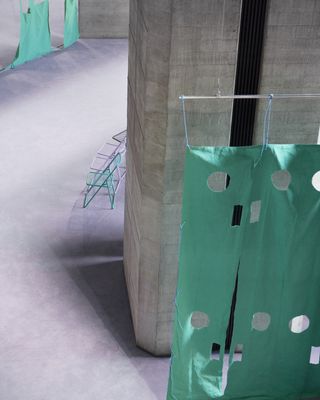In 1990, Sarah Lucas and Henry Bond took over a cavernous multi-story industrial warehouse in London’s Docklands, giving themselves and a handful of other rising Goldsmith graduates a vast floor each to fill with their work. Described by critics as a display of ‘calculated anarchy’ in rooms far larger than any gallery would dream of offering them, the controversial East Country Yard Show was just one example of the enterprising antics of the newly-bonded YBAs, who were on the cusp of forcing British art into a daring new era of openness and creativity.
One of these artists was the soon-to-be stratospheric Gary Hume, who presented a series of hauntingly beautiful pieces made from forest-green industrial tarpaulin used to cover lorries on the docks. Entitled ‘Bays’, they were slashed and sewn to resemble entryways and windows in the style of his famous ‘Door’ paintings, which infused human emotion into abstract hospital doors rendered in candy-coloured Dulux paint. Unlike his widely-exhibited ‘Doors’ however, Hume hadn’t returned to ‘Bays’ until 2024, when he received a message from Burberry’s creative director, Daniel Lee.
Gary Hume on his collaboration with Burberry’s Daniel Lee

The show took place at the Brutalist lobby of London’s National Theatre
(Image credit: Courtesy of Burberry)
‘I don’t know how he came across them,’ the artist says. It’s a drizzly Sunday evening, and we’re sitting beside each other on the floor in a quiet corner of an otherwise busy opening at Sprüth Magers gallery in Mayfair. It’s been a big week for the gentle-natured artist, who is showing a new body of work here as part of three concurrent London exhibitions marking 25 years since he represented Britain at the Venice Biennale. ‘I hadn’t touched the pieces in a long time, and so when Daniel asked me if I could participate in his show, I said yes.’
Shown this afternoon at the National Theatre, an original set inspired by ‘Bays’ provided a backdrop to Lee’s confident new collection for Burberry. ‘The green in the pieces was weirdly very similar to surgeon’s gowns, so there was this nice mixture of modernism and a feeling of being saved,’ says Hume of the original works, versions of which adorned the concrete walls, their medical green echoed in snaking metal seats through the theatre. Similarly foreign and familiar, Lee’s clothes dug deeper into his succinct vision for the British house, bringing fresh summery lightness to trenches, checks and silhouettes that twisted ideas of classic English glamour. It was, says the show notes, grounded in ‘joy and a warm sense of familiarity’.

(Image credit: Courtesy of Burberry)
Previously staging his shows for Burberry in tents, the decision to show inside the Brutalist monolith on the South Bank was actually driven by Hume. ‘Well, it was very difficult, I think – for them,’ he says with a smile. ‘We needed to find a space big enough for the works. Fortunately, I wasn’t the one suffering, saying, “We think we might be able to get this amazing concrete building made in a Brutalist style”. The tarpaulins were first shown in an industrial building, it was raw concrete, and the National Theatre has got a sensation of that. It’s very beautiful.’
Though he’s dressed beautifully for the opening, in a soft ecru cashmere jumper and smart black suit trousers, fashion is a world unfamiliar to Hume. ‘Well, to be honest, I don’t really know,’ he answers when I ask what he thinks of Lee’s work. ‘I work six days a week and I’m covered in paint all the time. My clothes are old, and they go down the line until they become studio clothes, then they’re covered in paint. That’s when I’m really happy, and that’s when I feel most myself.’

A look from the show, which was grounded in ‘joy and a warm sense of familiarity’
(Image credit: Courtesy of Burberry)
Despite this, he felt an admiration for the way ex-Bottega Veneta designer works. ‘There was a real bond of being two creative people,’ the artist says. ‘It’s fascinating and fun to be around someone who has to work so quickly. There’s so much pressure on him. This show you’re in now, this is two years’ work, and Daniel is showing, I don’t know, three months’ work or whatever it might be. I think we were wowed by each other – that he’s like that, and that I can spend two years. It’s just two different ways.’
Turning to the twisting, dark and pastel paintings on the walls of Sprüth Magers, the result of these two years, Hume pauses. Like many of his later works, they explore feelings of awe and alienation through the natural world, in particular seeking something stirring in the otherworldliness of birds. After a moment, he says they were an exercise in getting lost – a goal surprising for an artist as established as he is, at a moment he is being celebrated for a milestone as significant as his 1999 Venice Biennale display.

One of the tarpaulins which featured in the show
(Image credit: Courtesy of Burberry)
‘I’m very, very keen on the shape that swans make,’ he explains. ‘Other than that, I didn’t want to know what I was doing. I wrestled with all of the paintings, because even when I found them to be good, I then broke them. I made them over and over and over and over and over again until they just arrived. It was about being lost really. I wanted to be lost until I was found.’
At the end of our interview, I ask if he ever thinks about how his work makes others feel when they encounter it – here in the intimate space of the gallery, or surrounded by crowds at a fashion show. ‘I don’t think about it,’ he says. ‘But that you’re human, and that you were born, and you’re looking at a picture, that is fucking fantastic.’
burberry.com
